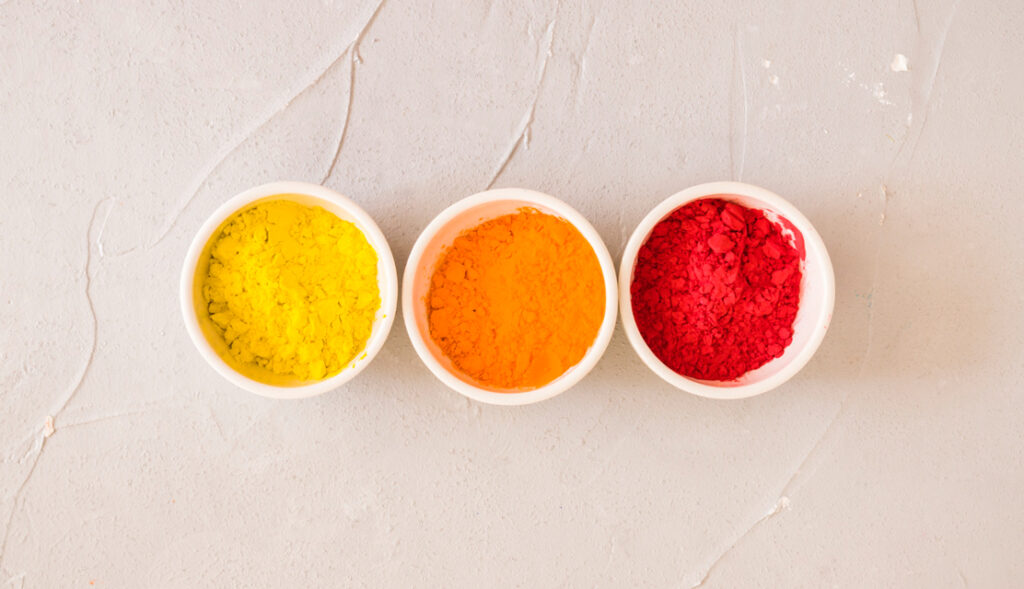The vibrant colors of processed foods often contribute to their visual appeal. Food dyes, both natural and synthetic, play a significant role in enhancing the aesthetics of various products lining our grocery store shelves.
However, some individuals may experience adverse reactions due to food dye allergies.
Ever wondered why certain colorful foods don’t quite sit well with you? If you suspect a food coloring allergy might be the culprit, you’re in the right place. This article will help you recognize the signals your body might be sending and providing straightforward tips on how to manage food coloring allergies.
Food Coloring Allergy Symptoms
Food coloring allergies can manifest through a range of symptoms, varying from mild to severe. The specific symptoms experienced by individuals can depend on the type of food coloring, the amount consumed, and the individual’s sensitivity.
Here are some common food coloring allergy symptoms:
- Hives
- Rash
- Sneezing and nasal congestion
- Wheezing or asthma-like symptoms
- Nausea and vomiting
- Abdominal pain and diarrhea
- Migraines or headaches
- Hyperactivity (subject to ongoing research and debate)
- Difficulty breathing
- Swelling of the face and throat
- Rapid drop in blood pressure
- Loss of consciousness
Food Dyes That Can Cause Allergies

Certain food dyes, both natural and synthetic, have been associated with allergic reactions in susceptible individuals. It’s important to note that reactions can vary from person to person, and not everyone will experience allergies to the same extent or with the same dyes. Here are some food dyes that have been known to cause allergies.
Tartrazine (Yellow 5)
Tartrazine is a synthetic yellow dye commonly used in various food and beverage products. Allergic reactions to tartrazine may include skin rashes, hives, and respiratory symptoms.
Foods that may contain Yellow 5 include:
- Baked goods (cakes, pastries, cookies, and other baked goods)
- Desserts (puddings, custards, gelatin desserts, and ice creams)
- Candies, gummies
- Soft drinks and beverages (fruit-flavored drinks and energy drinks)
- Processed snacks (chips, crackers, and flavored popcorn)
- Instant noodles and pasta
- Breakfast cereals, instant oatmeal, and cereal bars
- Sauces, dressings, and condiments, including mustard and salad dressings
- Some pickled products and relishes
- Canned soups
Erythrosine (Red 3)
Widely used in the food industry to add a vibrant red hue to various products, Red 3 has garnered attention due to its potential health implications, causing an allergic reaction as skin irritation, gastrointestinal discomfort, or respiratory issues.
This synthetic red dye is used to color foods such as candies, popsicles, and baked goods.
While approved for use in foods by regulatory authorities in many countries, there have been debates and concerns regarding the safety of Erythrosine. Some studies have suggested potential links to thyroid tumors in animal models when consumed in large quantities. However, regulatory bodies such as the U.S. Food and Drug Administration (FDA) have deemed it safe for use within specified limits.
Due to safety concerns and consumer preferences, some food manufacturers have explored alternative natural colorings to replace or reduce the use of synthetic dyes like Erythrosine.
Allura Red AC (Red 40)
Red 40 is one of the most widely used artificial food colorings, giving products a vibrant red hue.
Red 40 is extensively utilized in the production of:
- Candies
- Desserts
- Beverages
- Cereals
- Condiments
In addition to its use in food products, Red 40 is employed in cosmetics, medications, and various personal care items to achieve a visually appealing color.
Red 40 has been associated with allergic reactions in some individuals. Allergic responses may include skin rashes, hives, respiratory symptoms, or gastrointestinal discomfort.
Brilliant Blue (Blue 1)
Blue 1, also known as Brilliant Blue, is a synthetic blue dye that finds extensive use in the food and beverage industry for its ability to impart a vibrant blue color to various products.
While widely approved for consumption, Blue 1, like other food dyes, has been subject to scrutiny regarding its safety and potential health effects.
Blue 1 is commonly used in a range of food items, including:
- Baked goods
- Candies
- Beverages
- Cereals
- Dairy products
Blue 1 is known for its stability in various food processing conditions. It is often used in products with a wide range of pH levels, making it suitable for a diverse array of food and beverage applications.
Some individuals may experience allergic reactions to Blue 1, leading to symptoms such as skin rash, itching, or respiratory discomfort. However, allergic responses to this dye are relatively rare.
Indigo Carmine (Blue 2)
Another blue synthetic dye, Blue 2, is used in some foods and medications. It is part of the indigoid class of dyes and has been employed for decades for its ability to produce vibrant and stable blue hues.
Blue 2 is commonly used in a variety of food products, including:
- Candies (gummies, hard candies, and coated chocolates)
- Baked goods (cakes, cookies, and pastries)
- Beverages (sports drinks, and certain sodas)
- Some processed foods (popcorn, snack mixes)
- Jams and jellies
As consumer preferences shift towards cleaner labels and natural ingredients, some food manufacturers are exploring natural alternatives to synthetic Blue 2 to meet the demands of an evolving market.
Sunset Yellow FCF (Yellow 6)
Yellow 6 is a synthetic yellow dye widely used in the food and beverage industry to add a bright and appealing golden-yellow color to various products.
Like other food dyes, Yellow 6 has been subject to regulatory scrutiny and discussions regarding its safety and potential health effects.
Yellow 6 is frequently employed in a variety of food and beverage products, including candies, desserts, baked goods, snack foods, and certain flavored beverages.
Allergic reactions to Yellow 6 result in symptoms such as skin rashes, itching, or respiratory discomfort.
Amaranth (Red 2)
Although less commonly used, Amaranth is a synthetic red dye that has been associated with allergic reactions. It has found use in products such as candies, jams, jellies, desserts, and certain processed foods. Symptoms may include skin irritation and respiratory issues.
Some studies have raised concerns about the potential health effects of Amaranth, particularly in high doses. While regulatory bodies have established acceptable daily intake levels, ongoing research continues to evaluate its safety.
Cochineal Extract and Carminic Acid (Red 4)
Derived from crushed cochineal insects and used extensively in the food industry to impart a vibrant red color to various products, Red 4 may cause allergic reactions in some individuals.
Potential allergic reactions:
- Itching, hives or welts
- Difficulty breathing, wheezing
- Nausea, vomiting
- Swelling of the face or lips
- Anaphylaxis (severe, life-threatening allergic reaction)
Individuals with known insect allergies may be at a higher risk of allergic reactions to Cochineal Extract. Cross-reactivity can occur, necessitating caution in such cases.
Foods containing Cochineal Extract and Carminic Acid (Red 4):
- Yogurts (especially with red fruit or berry flavors)
- Fruit juices, fruit-flavored drinks, and sodas.
- Red-colored candies, gummies, and confectionery items
- Red velvet cakes, pastries, and other baked goods
- Some processed foods, such as sauces, dressings, and certain snack items
Practical Tips for Food Allergy Control
Managing food allergies requires diligence and proactive measures to avoid potential triggers and respond effectively in case of accidental exposure.
Here are some advice and strategies for individuals managing food allergies:
Know Your Triggers
Identify specific foods or ingredients that trigger your allergies. Read food labels carefully to recognize potential allergens.
Learn About Cross-Contamination
Understand the risk of cross-contamination in food preparation. Be aware of shared cooking surfaces, utensils, and equipment that may come in contact with allergens.
Inform Others
Clearly communicate your food allergies to family, friends, restaurant staff, and anyone involved in food preparation. Make sure they understand the seriousness of your condition.
Read Labels
Scrutinize food labels for potential allergens. Manufacturers are required to disclose common allergens on labels.
Cook at Home
Prepare meals at home whenever possible to have better control over ingredients and avoid potential cross-contamination.
Plan Ahead for Social Events
Inform hosts or event organizers about your food allergies in advance. Discuss menu options and inquire about ingredients.
Carry Epinephrine
If prescribed by a healthcare professional, carry an epinephrine auto-injector (e.g., EpiPen) at all times. Ensure it is not expired and that you and those close to you know how to use it.
Wear Identification
Consider wearing a medical bracelet or necklace that indicates your food allergies. This can be crucial in case of emergencies.
Keep Updated
Stay informed about food recalls and changes in ingredient formulations. Subscribe to allergy alerts and newsletters.
Create an Allergy Action Plan
Work with your healthcare provider to create a personalized allergy action plan. Share this plan with family members, friends, and colleagues.
Ask Questions
When dining out, ask detailed questions about ingredients and food preparation methods. Choose restaurants with experience in handling food allergies.
Be Prepared for Travel
If traveling, research local cuisine and common allergens. Translate allergy information into the local language if needed.
Connect with Others
Join food allergy support groups or online communities to share experiences, tips, and advice with others facing similar challenges.
Regular Checkups
Schedule regular checkups with an allergist to monitor your condition, discuss any concerns, and update your allergy action plan.
Conclusion

Remember this: understanding your body’s signals is like having a superpower. Armed with the knowledge of food coloring allergies, you’re better equipped to savor life’s flavors without unwelcome surprises.
Take a step further in ensuring your safety and enjoyment with the UMA app. Designed for individuals with food allergies and intolerances, UMA makes dining out a breeze.
Download now on the App Store and Google Play, and let UMA be your trusty companion in navigating menus and savoring meals safely.
Happy eating!

